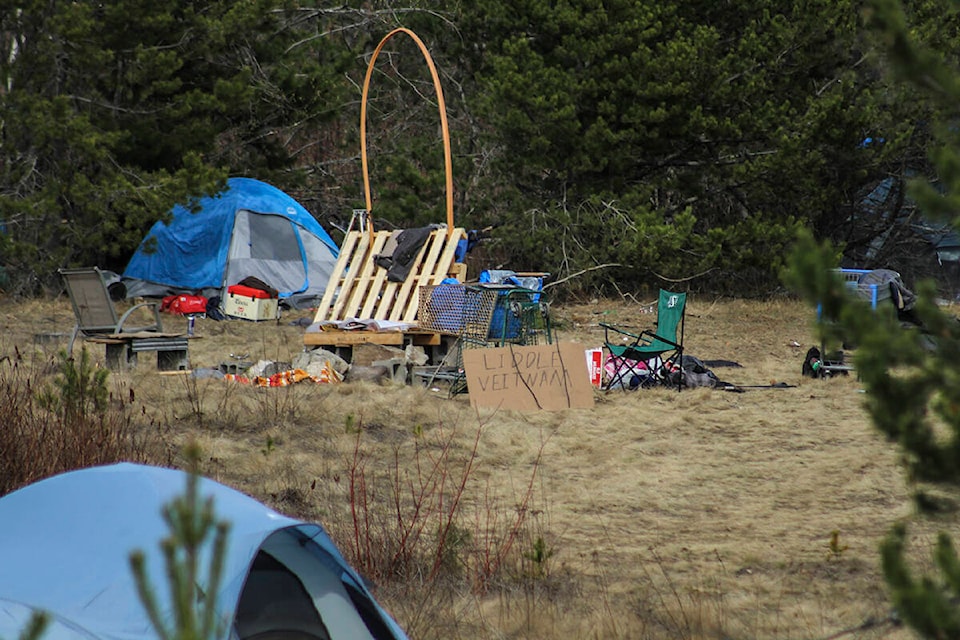City of Terrace council members struggled to understand where the community’s homeless population comes from upon receiving the results of this year’s homelessness count on July 11. Even with newer housing options in Terrace the count increased from 71 in 2019 to 84 in 2022.
Councillors also questioned the accuracy of the count in speaking with officials from the Ksan Society, who conducted the count over a 24-hour period from the evening of April 11 into the evening of April 12 within city limits.
“It’s certainly my perception, and others in town, is that we have an increase of people on the street in the community in 2022,” Coun. Dave Gordon told Ksan executive director Amanda Owens and counselling and support programs director Lisa Schmidt in wondering why that wasn’t represented in the count.
Owens told Gordon there is no one answer to the question because the number of homeless encountered on any one day could depend on factors like the weather and time of year. “It seems there’s more people out now than there was in April,” she said.
Both Owens and Schmidt said they’ve heard of homeless camps now being set up along Queensway Drive and at other locations in Thornhill and because that is outside the city limits, there was no count taken. Owens said camps are now being set up now outside city boundaries in part because of the increase in city employees policing the homeless population in Terrace. The Ksan Society recommended next year’s count extend into the Thornhill area to account for those camps.
“As much as they’re outside the community, they’re still part of the community,” agreed Coun. Sean Bujtas.
Bujtas zeroed in on their communities of origin before coming to Terrace, asking at what point people are considered to be locals. Of the 32 people who responded to the question about community of origin in the Ksan survey, 12 said they were from Prince Rupert, seven from Kitimat and two from Smithers/Telkwa.
Another 11 said their community of origin was Terrace. Thirty out of 59 people said they had been homeless for more than a year and 29 said they had been homeless for less than a year according to the survey.
Of the 61 people who provided their length of time in Terrace, 10 said they had always been in Terrace, 26 said they had been here more than a year, 15 for less than a year, eight had been here from one week to one month and two for a matter of days.
“At some point they permanently reside here, regardless if they’re housed or not,” said Bujtas. “But you know, you get all these rumours of people being bussed into town or however they’re coming here.”
Bujtas called it “alarming” that of the 32 people who provided a community of origin, the majority were not from Terrace. “There’s more people on the street currently that are from Rupert than there are from Terrace,” he said.
Bujtas said it would also be interesting to know if people without housing were homeless when they left their communities of origin. Owens replied that one challenge of the survey was how people considered their own circumstances and that some answers might not be accurate.
Coun. Brian Downie wanted to know if there’s a difference between a community where people left to come to Terrace as opposed to their community or origin, wondering if that might apply to people from the Indigenous villages around Prince Rupert and the Nass Valley.
Schmidt told Downie that level of detail was not readily available. Downie also wondered if people were being drawn to Terrace because of the services available here while Bujtas said it was clear the city is a regional hub.
Overall the 84 people counted as homeless in this year’s survey is higher than the 74 people counted in 2021 and the 71 counted in 2019. Of those counted this year, 64 filled out a survey either partially or in full.
The majority of people counted were older Indigenous men and the top two reasons for being unhoused were listed as addictions or lack of income. Of those providing survey information, 43 were men, 21 were women and two were non-binary.
Since 2014 the City of Terrace has conducted annual homeless counts to better understand the situation and to collect data to then lobby the provincial government for assistance. Ksan Society is the city’s contractor in conducting the count.
In 2014, the count identified 67 people as homeless, a figure rising to 73 in 2015 and to 113 in 2016, dropping to 63 in 2017 and rising again to 96 in 2018. The pandemic prevented a count being taken in 2020.
READ MORE: Terrace city hall proposed as site for overnight tent city
READ MORE: Fire impacts Terrace encampment by CN railway tracks
